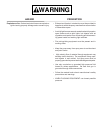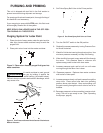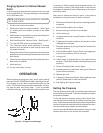
4
• Maximum operating range of the gun - 3000 PSI fluid
pressure.
• NEVER aim the gun at any part of the body.
• NEVER allow any part of the body to come in contact
with the fluid stream. DO NOT come in contact with a
fluid stream created by a leak in the fluid hose.
• NEVER put hand in front of the gun. Gloves will not
provide protection against an injection injury.
• ALWAYS lock the gun trigger,shut fluid pump off and
release all pressure before servicing, cleaning tip guard,
changing tips, or leaving unattended. Simply turning off
the motor will not release pressure in the system. The
Prime Spray Valve must be turned to the position to
relieve the pressure. See Pressure Relief Procedure,
Page 10.
• ALWAYS have the tip guard in place while spraying. The
tip guard provides some protection against injection
injuries but is mainly a warning device.
ALWAYS remove spray tip before flushing or cleaning
the system.
WARNING
PREVENTION
HAZARD
• NEVER use a spray gun which does not have a trigger
lock or trigger guard in place and in working order.
• All accessories must be rated at or above 3000 PSI
(Includes spray tips, guns, extensions, and hose).
Injection Injury - A high pressure stream of paint pro-
duced by this equipment can pierce the skin and
underlying tissues, leading to serious injury and pos-
sible amputation.
DO NOT TREAT AS A SIMPLE CUT! Injection-
can lead to amputation. See a physician im-
mediately.
NOTE TO PHYSICIAN: Injection into the skin
is a traumatic injury. It is important to treat
the injury surgically as soon as possible. DO
NOT delay treatment to research toxicity.
Toxicity is a concern with some coatings
injected directly into the blood stream. Con-
sultation with a plastic surgeon or recon-
structive hand surgeon may be advisable.
•
• Paint hose can develop leaks from wear, kinking, abuse
etc. A leak is capable of injecting material into the skin.
The paint hose should be inspected before each use.
• In case of skin injection, see physician immediately.


















